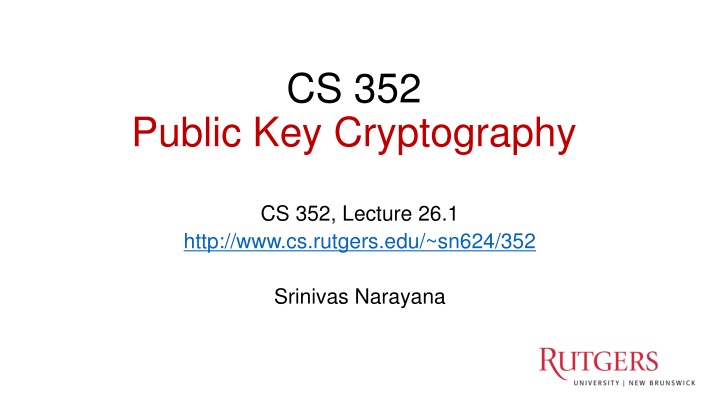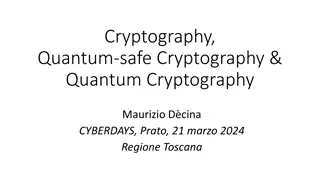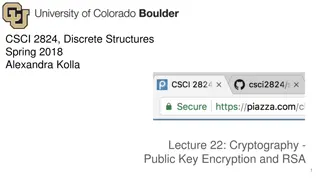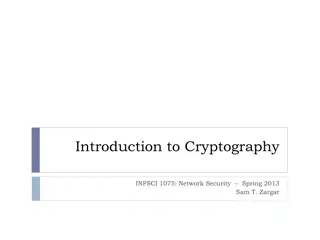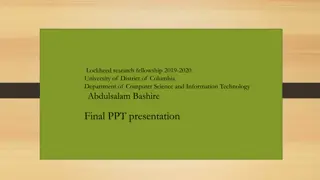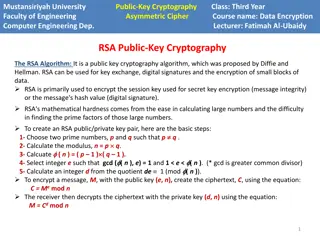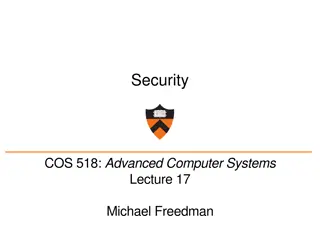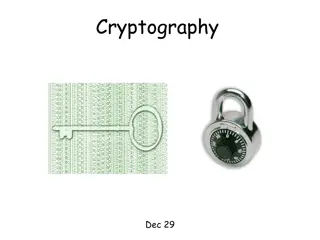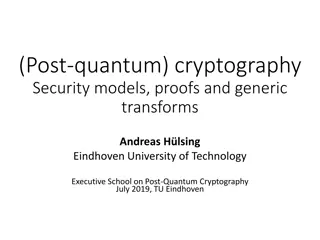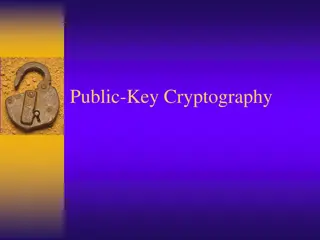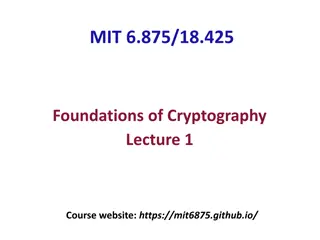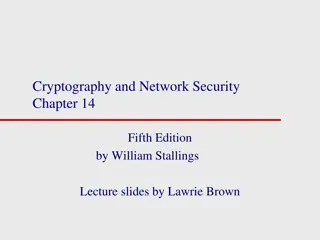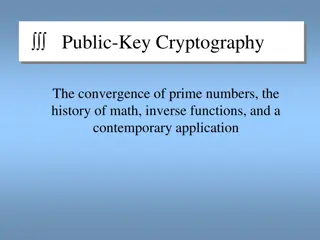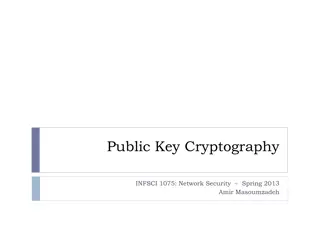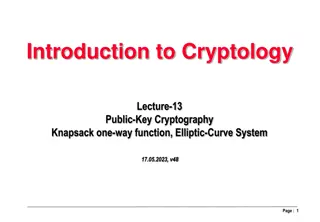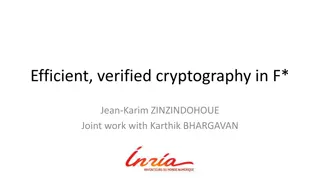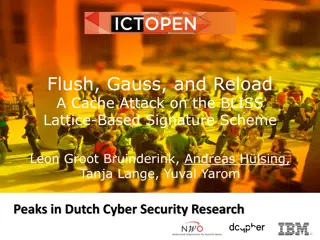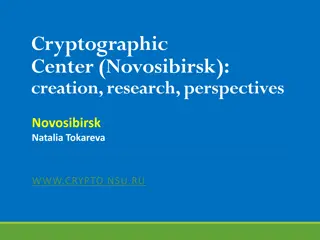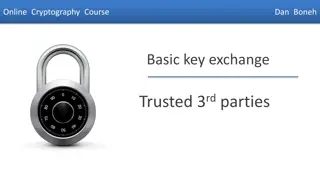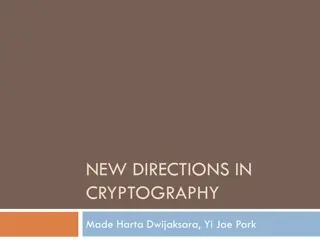Public Key Cryptography Overview
Public Key Cryptography, also known as asymmetric cryptography, is a powerful technique used to secure communications over insecure networks. It involves the use of public and private keys for encryption and decryption, allowing secure exchange of information without the need for pre-shared keys. This method addresses the challenge of securely exchanging keys over insecure networks and ensures only intended parties can access the encrypted data.
Download Presentation

Please find below an Image/Link to download the presentation.
The content on the website is provided AS IS for your information and personal use only. It may not be sold, licensed, or shared on other websites without obtaining consent from the author.If you encounter any issues during the download, it is possible that the publisher has removed the file from their server.
You are allowed to download the files provided on this website for personal or commercial use, subject to the condition that they are used lawfully. All files are the property of their respective owners.
The content on the website is provided AS IS for your information and personal use only. It may not be sold, licensed, or shared on other websites without obtaining consent from the author.
E N D
Presentation Transcript
CS 352 Public Key Cryptography CS 352, Lecture 26.1 http://www.cs.rutgers.edu/~sn624/352 Srinivas Narayana 1
Security and the Network Stack Application FTP HTTP HTTPS SMTP DNS Security: cuts across all parts of the network stack! Transport UDP TCP IP Network 802.3 802.11 ATM Link
Review: Cryptography Alice s encryption key Bob s decryption key KA KB Alice Bob KB(KA(m)), plaintext KA(m), ciphertext encryption algorithm m, plaintext decryption algorithm Trudy KA and KB are the same: symmetric key cryptography (last lecture) KA and KB are different: public key cryptography This lecture!
Agreeing on shared secret key is hard Communicating parties may never meet in person It s very common not to meet someone you talk to over the Internet Amazon? Your bank? And what if the shared secret is stolen? Must exchange keys securely again! Q: how to exchange keys securely over an insecure network? Use public key cryptography to bootstrap a shared secret key
Terminology Alice and Bob each have a pair of keys One key is public: the public key is known to all. Assume public keys can be exchanged securely The other key is secret to each communicating party: private key Alice Bob Known to both Alice and Bob KA+ KB+ Alice s public key Bob s public key KA- KB- Alice s private key Bob s private key Only known to Bob (unknown to Alice) Only known to Alice (unknown to Bob)
Public key cryptography KB+ Bob s public key Note: encryption uses Bob s public key, not Alice s. KB- Bob s private key Alice Bob encryption algorithm decryption algorithm ciphertext K (m) B Plaintext message Plaintext message m = K (K (m)) B + - + m B A message encrypted with Bob s public key can only be decrypted using Bob s private key. The message cannot be decrypted with Bob s public key. So, only Bob can decrypt them.
Public key crypto: What do we need? Invertible encryption: For each communicating entity, we need algorithms and keys K+ and K- such that m = K-(K+(m)) Given a public key K+, it must be intractable to compute the private key K- (let s call this the one-way property) Given ciphertext K+(m), it must be intractable to compute the plaintext m (confidentiality) Sometimes, also authentication/non-repudiation (more later) m = K+(K-(m))
Public key cryptosystems Diffie-Hellman Key distribution, confidentiality Digital Signature Algorithm (Schnorr/ElGamal) Authentication and non-repudiation Rivest, Shamir, Adleman (RSA) Key distribution, confidentiality, authentication, non-repudiation Subject of next module
CS 352 The RSA cryptosystem CS 352, Lecture 26.2 http://www.cs.rutgers.edu/~sn624/352 Srinivas Narayana 10
Review: Public key cryptography KB+ Bob s public key KB- Bob s private key Alice Bob encryption algorithm decryption algorithm ciphertext + Plaintext message Plaintext message m = K (K (m)) B - + m K (m) B B Three requirements for a public key cryptosystem: (1) Invertible encryption: m = K-(K+(m)) (2) One-way property: intractable to compute K- from K+ (3) Confidentiality: intractable to compute m from K+(m) This module: the RSA cryptosystem
Prerequisite (1): modular arithmetic x mod n = remainder of x when divided by n (% operator in C) Some facts: (x mod n) mod n = x mod n [(a mod n) + (b mod n)] mod n = (a+b) mod n [(a mod n) * (b mod n)] mod n = (a*b) mod n Can use these to show other useful properties: (a mod n)d mod n = ad mod n example: x=14, n=10, d=2: (x mod n)d mod n = 42 mod 10 = 6 xd = 142 = 196 xd mod 10 = 6
Prerequisite (2): Integer interpretation Messages (plaintext and ciphertext) are just bit sequences, can be broken into blocks of fixed length Blocks (of fixed length) may be interpreted as integers Algorithms over integers may be applied to message blocks Example: suppose m = 100100012. This is 14510 It is meaningful to say we apply modular arithmetic on a message
RSA Key Generation 1. choose two large prime numbers p, q. (e.g., 1024 bits each) 2. compute n = pq, and z = (p-1)(q-1) 3. choose e (with e < n) that has no common factors with z (e, z are relatively prime ). 4. choose d such that ed-1 is exactly divisible by z. (in other words: ed mod z = 1 ). 5. public key is (n,e). private key is (n,d). + - K B K B
RSA Encryption and Decryption 0. given (n,e) and (n,d) (computed during key generation) 1. to encrypt message m (< n), compute c = memod n 2. to decrypt the received ciphertext, c, compute m = cd mod n
An example of RSA Bob chooses p=5, q=7. Then n=35, z=24. Say e=5 (so e, z relatively prime). d=29 (so ed-1 exactly divisible by z). Suppose we are encrypting 8-bit messages. me e Int plaintext m c = m mod n Ciphertext encrypt: 17 248832 12 00001100 cd d ciphertext c m = c mod n Same plaintext! decrypt: 17 12 481968572106750915091411825223071697
RSA satisfies the three requirements Given c = memod n and m = cd mod n Invertible encryption: can show that m == m: i.e., m == (me mod n)d mod n c Fact: for n = pq and z = (p-1)(q-1), xy mod n = x(y mod z) mod n Then cd mod n = (me mod n)d mod n = med mod n = m(ed mod z) mod n = m1 mod n == m
RSA satisfies the three requirements One-way property: Suppose we know the public key (n, e). How hard is it to determine the private key (n, d)? The most viable method that exists is to factor n into p and q, determine z=(p-1)(q-1), then use e to find d, since ed mod z = 1. This assumes n can be factored into p and q: no one (publicly) knows efficient algorithms to factor large products of primes (integer factoring problem)
RSA satisfies the three requirements Confidentiality: Suppose we know the public key (n, e) and ciphertext c (me mod n). How hard is it to find the message m? The RSA problem: computing the e th root of c mod n. The most viable method requires factoring large numbers, for which efficient algorithms are not (publicly) known. Note: small numbers can be factored quite effectively Your RSA public and private keys must contain many bits (2048 or more)
RSA can also provide authentication! Turns out that K+(K-(m)) == K-(K+(m)) Encrypt with private key decrypt with public key Encrypt with public key decrypt with private key Follows from the rules of modular exponentiation: (me mod n)d mod n = med mod n = mde mod n = (md mod n)e mod n Next module: we ll see how to use this for authentication!
RSA is computationally expensive Exponentiation in RSA is computationally intensive DES (symmetric cipher) is orders of magnitude faster than RSA Strategy: use public key crypto to establish a secure connection, then establish second key, a symmetric session key KS for encrypting and decrypting the data.
Session keys: A simple example KB+( I m Alice ) KA+( I m Bob , KS) Bob Alice KS(m) Subsequent messages protected with KS Use public key crypto to exchange per-session symmetric keys All further communication occurs with symmetric key crypto
RSA: Summary A public key cryptosystem: use a pair of keys, public and private. Only public keys need to be exchanged RSA key generation, encryption, and decryption all involve modular arithmetic Security guarantees rely on the hardness of factorizing large numbers RSA is computationally heavy Use as a method to establish per-session symmetric keys used to encrypt and decrypt data
CS 352 Key Certification CS 352, Lecture 26.3 http://www.cs.rutgers.edu/~sn624/352 Srinivas Narayana 25
Review: Public key cryptography KB+ KB- Bob s public key Bob s private key Alice Bob encryption algorithm decryption algorithm ciphertext + Plaintext message Plaintext message m = K (K (m)) B - + m K (m) B B Three requirements for a public key cryptosystem: (1) Invertible encryption: m = K-(K+(m)) (2) One-way property: intractable to compute K- from K+ (3) Confidentiality: intractable to compute m from K+(m) RSA: satisfies all 3, and also, m = K+(K-(m)) How to use this for authentication
RSA for authentication: Login system Bob runs a login server to provide access to protected resources Can Alice and Bob use RSA for authentication, rather than a pre-determined password?
Simple authentication using RSA I m Alice, KA+ I m Bob, nonceB KA-(nonceB) Bob Alice ? nB == KA+(KA-(nB)) Alice sends her public key to Bob Bob sends a nonce The nonce is the challenge that Alice must use to show that she holds the private key corresponding to the public key Alice responds with the nonce encrypted with Alice s private key Bob can decrypt the nonce using Alice s public key to check its validity
Simple authentication using RSA I m Alice, KA+ I m Bob, nonceB KA-(nonceB) Bob Alice ? nB == KA+(KA-(nB)) Assume only Alice holds Alice s private key Only Alice could have encrypted Bob s nonce with Alice s private key. So Bob can authenticate Alice to use server resources Do you see a problem?
Bad to exchange keys insecurely! I m Alice, KA+ I m Alice , KT+ I m Bob , nB KA-(nB) I m Bob, nB KT-(nB) Alice Trudy Bob Indeed nB = KT+(KT-(nB)) Trudy can perform an entity-in-the-middle attack! Trudy pretends to be Alice to Bob and Bob to Alice Bob thinks KT+is Alice s key, Alice thinks Bob is sending nonce Problem exists even if Bob encrypts nonce with Alice s public key
One cannot just trust public keys Suppose Alice sends Bob KA+, Bob sends Alice KB+ I m Alice, KA+ I m Bob, KT+ I m Alice, KT+ I m Bob, KB+ Bob Alice Trudy Every message can be decrypted and re-encrypted by Trudy Including symmetric session keys that might be exchanged Trudy can evade detection completely: plaintext received by Alice and Bob are identical to those without the attack
You cant just trust a public key, since it is unclear whether the key is tied to the entity you re talking to. (it s like someone calling you and claiming they re from your bank or the IRS) Q: Is there a way to reliably know the public key of an entity you re communicating with?
Key certification Trust someone else (a centralized authority)to check public keys for us On the Internet, and in real life, trust is transitive If X trusts Y, and Y trusts Z, then X can trust Z E.g., Bob trusts a key certification authority (CA) The certification authority trusts Alice s public key Hence, Bob can trust Alice s public key
Certificate Authority Certificate authority (CA): binds a public key to particular entity Analogy: the Department of Motor Vehicles binds your details (name, address, age, etc.) to your identity (social security) after checking them Entity E (e.g., web site, router) registers its public key with CA E provides proof of its identity to the CA CA creates a certificate binding E to its public key Analogy: the driver s license is your certificate
Certificate Authority The CA uses a mechanism called a digital signature to perform this binding in an unforgeable manner We ll learn about digital signatures in the next lecture Effectively, the CA attests this is E s public key Checking the signature requires the CA s public key For the web, this key is shipped with your browser installation + digital signature (encrypt) K A + K A Alice s public key CA s private key K CA certificate for Alice s public key, signed by CA - Alice s identifying information Certificate Authority (CA)
Authentication using certificates Extract Alice s public key: trusted Alice K A Bob digital signature (decrypt) I m Alice, certA + + + K A K A I m Bob, nB KA-(nB) , certB + K B CA + public key K CA Extract Bob s public key When Alice authenticates herself, she sends Bob her certificate Bob extracts Alice s public key using the certificate and CA s public key If needed, Bob can authenticate himself to Alice using his cert It is possible for Bob to start trusting Alice s public key using other methods: e.g., a web of trust, like PGP
Summary of key certification Exchanging public keys over an insecure channel is bad Need a way to bind a public key to an entity in a trustworthy manner Certificate authorities bind public keys to entities Mechanism of digital signatures (next lecture) Need the CA s public key to extract the entity s public key Extracted public key can then be used to challenge the communicating entity, e.g., through nonces
Public Key Cryptography: Summary Public key cryptography is powerful No need to exchange secret keys securely Only the receiver of encrypted information holds the secret key Public keys are exactly that: public! Useful as a mechanism to exchange symmetric keys later on Crypto algorithms fundamentally support Internet security Algorithms like AES and RSA are used widely on servers HTTPS uses these ciphers (more later) Next lecture: use crypto as building block for integrity and non-repudiation
